- High Vitamin C Therapy
Prevention of infectious complications after primary hip or knee arthroplasty with high-dose intravenous vitamin C therapy.
Swedish-Ukrainian Hospital ‘Angelholm’
Keywords: vitamin C, hip arthroplasty, postoperative wound healing.
Introduction
Ascorbic acid (vitamin C) is a water-soluble vitamin that promotes optimal tissue metabolism. Its active participation in redox reactions, results in the formation of a system of hydrogen proton transfer with dehydroascorbic acid thereby ensuring the stability of cell membranes. Vitamin C, participates in the synthesis of the main substance of the connective tissue of the vascular wall, thus preventing the development of hemorrhagic diathesis. However, it is not synthesized in the human body. Insufficient intake of ascorbic acid with food develops bleeding from the gums, and mucous membranes. (Nualart, Rivas et al. 2003).
Free radicals are inactivated by ascorbic acid, which prevents ascorbic acid from damaging cell membranes, including lymphocytes, due to peroxidation. This action causes a number of immunomodulatory effects, including enhanced chemotaxis, synthesis and release of interferon, which improves lymphocyte migration.
Wound healing is a complex intertwining of many processes that are actually divided into three phases: inflammation or cleansing, proliferation and tissue remodelling. Vitamin C, due to its importance for neurosensory and immunological processes, is involved in perfusion and revascularization, as well as in the synthesis of collagen as the main substance at all stages. Deficiency leads to impaired wound healing, vascular fragility and inadequate immune response (Campos, Groth et al. 2008).
Vitamin C is a coenzyme of hydroxylases of proline and lysine enzymes involved in collagen biosynthesis. These elements are necessary for the synthesis of a small number of connective tissue cells of collagen of the correct structure. Ascorbic acid is not only a major factor in the formation of strong and stable fibrillar fibres for collagen synthesis but also a stimulant. This was shown by an experimental study of human skin fibroblasts, where intravenous administration of vitamin C for 5 days significantly improved the synthesis of collagen I and IV (Kishimoto, Saito et al. 2013). No type of collagen can be formed without ascorbic acid, and this explains many of the symptoms of vitamin C deficiency: poor wound healing, haemorrhage and inflammation of the mucous membranes (gums) and skin. Skin problems are characterized by increased vascular fragility with haemorrhage (petechiae, ecchymoses, perifollicular haemorrhages), inflammation and hyperkeratosis. In preclinical studies in guinea pigs, which, like humans, are unable to synthesize vitamin C, it has been observed that collagen synthesis is reduced by 50% in ascorbic acid deficiency (Hagel, Layritz et al. 2013).
During stress reactions, the content of ascorbic acid in the body and in the tissue of the adrenal glands, in particular, is significantly reduced, which confirms the participation of ascorbic acid in adaptation reactions. It is able to have an antianemic effect due to the effect on iron metabolism, as the restoration of ferric to divalent iron, is transported with the bloodstream.
Vitamin C improves cellular immunity and affects processes such as phagocytosis, chemotaxis, T lymphocyte proliferation, the activity of natural killer cells, and the synthesis of interferon, immunoglobulin and coenzymes (Panush and Delafuente 1985). Prophylactic administration of vitamin C protects against infections in animal experiments and in clinical trials in humans (Sahoo and Mukherjee 2003), and subclinical conditions of vitamin C deficiency increase susceptibility to infections (Frikke-Schmidt and Lykkesfeldt 2009). In chronic infections, oxidative stress occurs, which is combined with insufficient levels of ascorbic acid and correlates with the severity of the disease (Vollbracht, Raithel et al. 2018). Immune response disorders and increased susceptibility to infections create a vicious circle (Kowalski, Janiszewska-Drobinska et al. 2004).
Experimental studies to assess fracture healing in elderly patients clearly show that the level of vitamin C in the blood correlates with the stability of bone marrow formation. Preclinical studies have shown that administration of vitamin C (200 mg / kg body weight) 2-3 times a week for 3 weeks leads to accelerated callus formation and fracture healing (Alcantara-Martos, Delgado-Martinez et al. 2007).
The aim of the work is to improve the results of treatment of patients and reduce the risk of infectious complications after hip or knee replacement surgery with high-dose intravenous vitamin C therapy in the preoperative and early postoperative period.
Materials and methods: The results of treatment of 1,058 patients who underwent surgery at the Swedish-Ukrainian Medical Center "Angelholm" for the period from 2021 to 2022 performed primary hip or knee arthroplasty and introduced 7.5 g. vitamin C 30 minutes before the planned surgical treatment, 15 gr. ascorbic acid in the first 24 and 48 hours after surgery. Patients were divided into two groups: Group I - patients who underwent primary arthroplasty of the hip or knee joint without the use of infusion therapy of ascorbic acid - 358 patients; Group II - patients who underwent primary hip or knee arthroplasty using ascorbic acid infusion therapy on days 0, 1 and 2 - 700 patients (Table №1). The mean age of patients was 63.2 ± 12.9 years (28 to 82 years). Evaluation of functional outcomes was performed using the Harris Hip Scale for the hip joint and the algofunctional Leken index for the knee joint. Assessment of wound healing after surgery was performed using clinical and laboratory methods. The analysis of laboratory parameters of haemoglobin and C - a reactive protein on the 0th, 1st, 3rd and 5th days was performed.
Table №1
Distribution of patients by pathology of the hip or knee joints
depending on gender and the use of vitamin C.
Pathology | Gender (%) | Without the use of infusion therapy of vitamin C. | With the use of infusion therapy of vitamin C. | |
| Male | Female |
|
|
Osteoarthritis of the hip joint of the third degree | 168 (15,9%) | 198 (18,7%) | 128 (12,1%) | 228 (21,6%) |
Aseptic necrosis of the femoral head of the fourth degree | 92 (8,7%) | 104 (9,8%) | 78 (7,4%) | 118 (11,1%) |
With / fracture of the femoral neck | 94 (8,9%) | 102 (9,6%) | 66 (6,2%) | 132 (12,5%) |
Dysplastic coxarthrosis of the third degree | 65 (6,1%) | 87 (8,2%) | 42 (4%) | 110 (10,4%) |
Osteoarthritis of the knee joint, third degree | 48 (4,6%) | 66 (6,2%) | 30 (3%) | 84 (7,9%) |
Aseptic necrosis of the condyles of the femur and tibia, third and fourth degree | 21 (2,1 %) | 21 (2,1%) | 14 (1,3%) | 28 (2,6%) |
Total: | 488 (43,3%) | 578 (54,7%) | 358 (34%) | 700 (66 %) |
Patients with hip pathology predominated (84.7%) over patients with knee problems (14.3%). The main group of patients consisted of patients with osteoarthritis of the hip joint of the third degree. (34.7%) and aseptic necrosis of the femoral head (20.2%). Vitamin C infusion therapy was performed in 25.2% of these patients. Early activation and active management of patients with a full range of rehabilitation measures according to the developed recommendations was carried out. On day 5, functional results were assessed using the Harris Hip Scale for the hip joint and the algofunctional Leken index for the knee joint. The average score was 84.26 ± 7.64 points.
Diagrams of the mean value of haemoglobin in the pre- (0th day) and postoperative (1st, 3rd, 5th days) period depending on the pathology and use of vitamin C infusion therapy.
Diagram 1
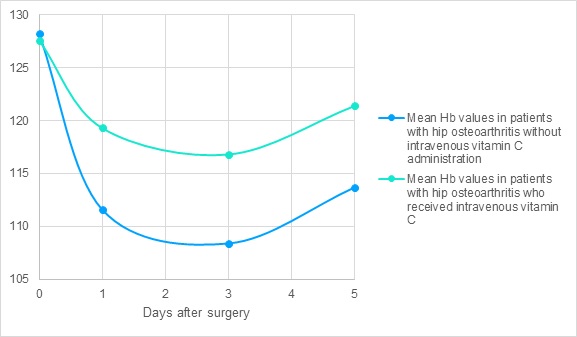
The analysis of changes in the mean values of haemoglobin in the early postoperative period in patients with deforming osteoarthritis of the hip, who underwent total hip arthroplasty using infusion therapy of vitamin C 7.5 - 15 g. compared to the control group, showed that the haemoglobin drop in patients using high-dose intravenous vitamin C therapy is lower, with a recovery of haemoglobin from the 1st to the 5th day is 9.4 g / l is higher.
Diagram 2
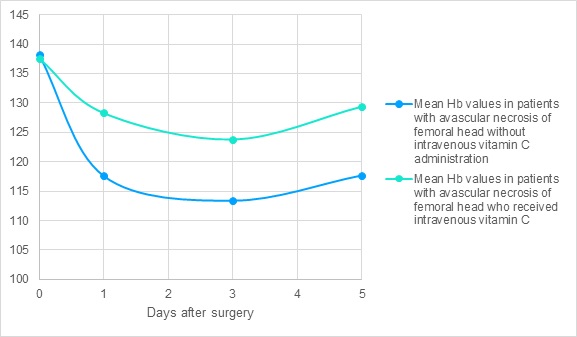
The analysis of changes in the mean values of haemoglobin in the early postoperative period in patients with aseptic necrosis of the femoral head, who underwent total hip arthroplasty using infusion therapy of vitamin C 7.5 - 15 gr. and without it showed that the diagram of the haemoglobin drop curve in patients using high-dose intravenous vitamin C therapy is lower, and the recovery of haemoglobin from the 1st to the 5th day is 10.6 g / l higher.
Diagram 3

The analysis of changes in the mean values of haemoglobin in the early postoperative period in patients with fractures of the femoral neck, who underwent total hip arthroplasty using infusion therapy of vitamin C 7.5 - 15 gr. and without it showed that the diagram of the haemoglobin drop curve in patients using high-dose intravenous vitamin C therapy is lower, and the recovery of haemoglobin from the 1st to the 5th day is 7.2 g / l higher.
Diagram 4

The analysis of changes in the average values of haemoglobin in the early postoperative period in patients with dysplastic coxarthrosis, who underwent total hip arthroplasty using infusion therapy of vitamin C 7.5 -15 g. and without it showed that the diagram of the haemoglobin drop curve in patients using high-dose intravenous vitamin C therapy is lower, and the recovery of haemoglobin from the 1st to the 5th day is 7.4 g / l higher.
Diagram 5

The analysis of changes in the mean values of haemoglobin in the early postoperative period in patients with osteoarthritis of the knee who underwent total knee arthroplasty using infusion therapy of vitamin C 7.5 - 15 g. and without it showed that the diagram of the hemoglobin drop curve in patients using high-dose intravenous vitamin C therapy is lower, and the recovery of hemoglobin from the 1st to the 5th day is 7.8 g / l higher.
Diagram 6
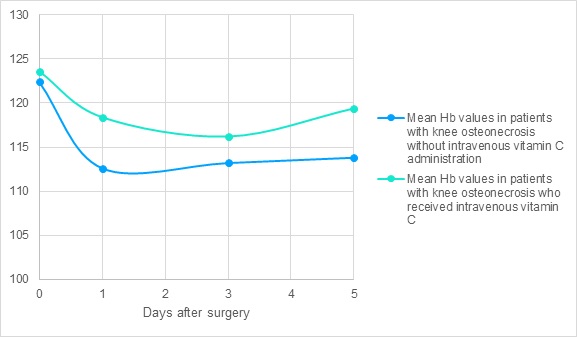
The analysis of changes in the mean values of hemoglobin in the early postoperative period in patients with osteonecrosis of the condyles of the femur and tibia, who underwent total knee arthroplasty using infusion therapy of vitamin C 7.5 - 15 gr. and without it showed that the diagram of the hemoglobin drop curve in patients using high-dose intravenous vitamin C therapy is lower, and the recovery of hemoglobin from the 1st to the 5th day is 7.0 g / l higher.
Diagrams of mean C-reactive protein in the pre- (0th day) and postoperative (1st, 3rd, 5th days) period depending on the pathology and use of vitamin C infusion therapy
Diagram 7

The analysis of changes in the mean values of C-reactive protein in the early postoperative period in patients with osteoarthritis of the hip, who underwent total hip arthroplasty using infusion therapy of vitamin C 7.5 - 15 g. and without it showed that the diagram of the rise in C-reactive protein in patients using high-dose intravenous vitamin C therapy is lower, and the rate of decrease in C-reactive protein from the 1st to the 5th day is 3.8 mmol / l lower.
Diagram 8
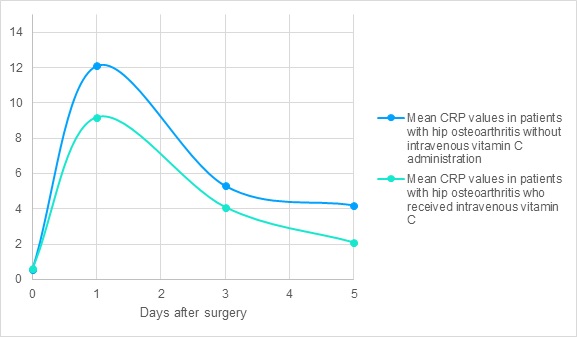
The analysis of changes in the mean values of C-reactive protein in the early postoperative period in patients with aseptic necrosis of the femoral head, who underwent total hip arthroplasty using infusion therapy of vitamin C 7.5 - 15 g. and without it showed that the diagram of the rise in C-reactive protein in patients using high-dose intravenous vitamin C therapy is lower, and the rates of decrease in C-reactive protein from the 1st to the 5th day by 5.2 mmol / l lower.
Diagram 9

The analysis of changes in the average values of C-reactive protein in the early postoperative period in patients with fractures of the femoral neck, who underwent total hip arthroplasty using infusion therapy of vitamin C 7.5 - 15 g. and without it showed that the diagram of the rise in C-reactive protein in patients using high-dose intravenous vitamin C therapy is lower, and the decrease in C-reactive protein from the 1st to the 5th day by 6.8 mmol / l lower.
Diagram 10

The analysis of changes in the average values of C-reactive protein in the early postoperative period in patients with dysplastic coxarthrosis, who underwent total hip arthroplasty using infusion therapy of vitamin C 7.5 - 15 gr. and without it showed that the diagram of the rise in C-reactive protein in patients using high-dose intravenous vitamin C therapy is lower, and the rate of decrease in C-reactive protein from the 1st to the 5th day is 3.2 mmol / l lower.
Diagram 11

The analysis of changes in the average values of C-reactive protein in the early postoperative period in patients with osteoarthritis of the knee, who underwent total knee arthroplasty using infusion therapy of vitamin C 7.5 - 15 g. and without it showed that the diagram of the rise in C-reactive protein in patients using high-dose intravenous vitamin C therapy is lower, and the rate of decrease in C-reactive protein from the 1st to the 5th day is 4.8 mmol / l lower.
Diagram 12
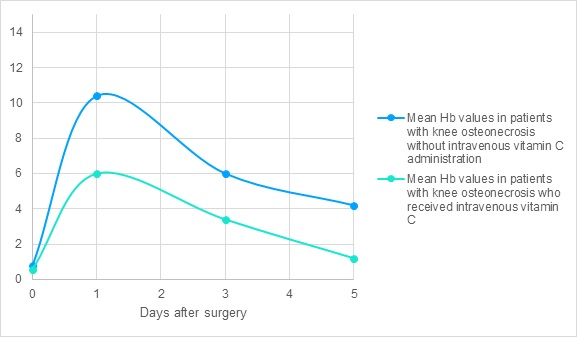
The analysis of changes in the average values of C-reactive protein in the early postoperative period in patients with osteonecrosis of the condyles of the femur and tibia, who underwent total knee arthroplasty using infusion therapy of vitamin C 7.5 - 15 gr. and without it showed that the diagram of the rise in C-reactive protein in patients using high-dose intravenous vitamin C therapy is lower, and the rate of decrease in C-reactive protein from the 1st to the 5th day is 6.4 mmol / l lower.
Research results and its discussion.
The analysis of the postoperative treatment of patients with pathology of the hip and knee joints after total arthroplasty of the hip or knee joint using high-dose intravenous vitamin C therapy has shown its effectiveness and justification. Due to the fact that in none of the 700 patients who received infusion therapy with vitamin C 7.5-15 g. according to the tested scheme, no early postoperative complications in the form of non-healing of the postoperative wound, hyperemia and severe edema of the operated area, ligature fistula were detected. The analysis of early postoperative complications of the control group of patients without the use of high-dose intravenous vitamin C therapy (Table №2) showed hyperemia and severe edema in 15.4% of cases, secondary tension healing in 4.3% of patients, superficial necrosis in 2% of cases and formation of ligature fistula in 2.56% of patients.
Picture 1- After the operative picture of patient K. born in 1957 and the appearance of the postoperative wound on day 5 after total hip arthroplasty.
Picture 2: Postoperative picture of patient S. born in 1959 and the type of postoperative wound on day 14 after total hip arthroplasty, fistula p / o scar.
The analysis of changes in the mean values of hemoglobin in the early postoperative period in patients with pathology of the hip or knee joints, who underwent total arthroplasty of the hip or knee joint using infusion therapy of vitamin C 7.5 - 15 gr. and without it showed that hemoglobin in patients with high-dose intravenous vitamin C therapy is higher, and hemoglobin recovery is better. Improving tissue repair and oxygenation, which promotes better tissue healing in the area of surgery and restoration of the functional state of patients.
The analysis of changes in the average values of C-reactive protein in the early postoperative period in patients with pathology of the hip or knee joint, who underwent total arthroplasty of the hip or knee joint using infusion therapy of vitamin C 7.5 - 15 gr. and without it showed that the indicators of C-reactive protein in patients using high-dose intravenous vitamin C therapy is lower, and therefore the overall immune response of the body to surgery is not so significant.
Therefore, vitamin C is necessary for the formation of strong collagen fibres, which promotes optimal wound healing, contractility and resilience. It promotes vascularization and protects blood vessels and nerves from oxidative stress, as well as reduces swelling and pain, preventing excessive inflammatory reactions, and improving protection against infections.
Conclusions.
1. Improved treatment outcomes and reduced risk of infectious complications after hip or knee replacement surgery with high-dose intravenous vitamin C therapy in the preoperative and early postoperative period.
2. Laboratory analysis of hemoglobin and C - reactive protein showed a decrease in immunological and inflammatory reactions of the body with the use of vitamin C in the pre- and postoperative period.
3. The scheme of intravenous administration of ascorbic acid in total hip and knee arthroplasty was developed and tested.
Prospects for further research.
We are planning to further study the effects of ascorbic acid in patients with deep periprosthetic infection of the hip or knee joints during the first stage of two-stage treatment in combination with antibacterial drugs to improve the treatment outcomes of such patients.
| Doctor | Name | Speciality | Work time (Sunday) |
|---|---|---|---|
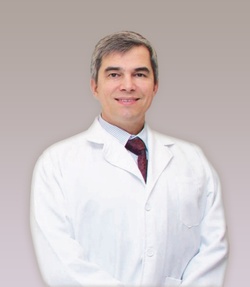 | Васильчишин Ярослав Миколайович | Отропед-травматолог | None - None |
Comments